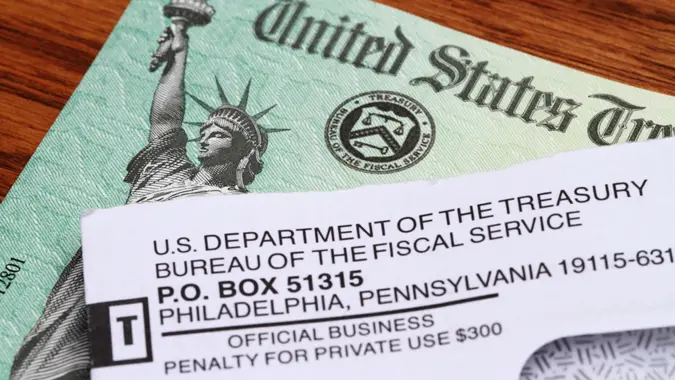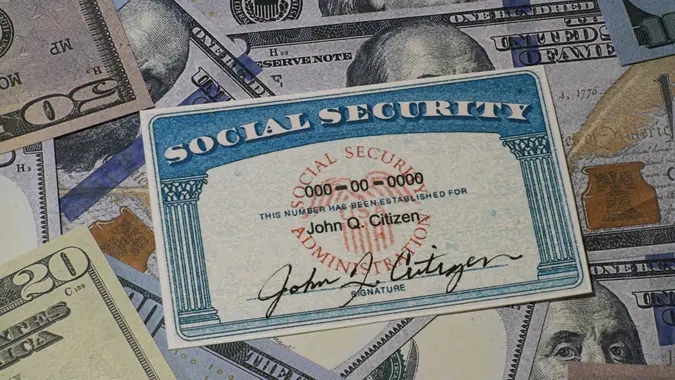What Would Happen If Social Security Benefits Were Cut in Half?

Commitment to Our Readers
GOBankingRates' editorial team is committed to bringing you unbiased reviews and information. We use data-driven methodologies to evaluate financial products and services - our reviews and ratings are not influenced by advertisers. You can read more about our editorial guidelines and our products and services review methodology.

20 Years
Helping You Live Richer

Reviewed
by Experts

Trusted by
Millions of Readers
Social Security works essentially as a safety net to help keep older adults and other vulnerable individuals out of poverty. While President Trump has said he won’t cut Social Security, the Department of Government Efficiency (DOGE) and the One Big Beautiful Bill Act (OBBBA) have made significant changes, including layoffs to Social Security Administration (SSA) staff and tax cuts, leading to questions about the fate of Social Security in the United States.
Additionally, analysts have been discussing for years whether the trust that funds Social Security will remain solvent or run out by the early to mid-2030s. Some have speculated that to truly “save” Social Security, it will be necessary to cut back on recipients’ benefits.
So, what would happen to current and future retirees if the amount that Social Security recipients received were cut in half?
The Immediate Impact
According to George Carrillo, CEO of the Hispanic Construction Council (HCC) and the former director of Social Determinants of Health for the state of Oregon, Social Security is not “just a policy. It is a promise, a lifeline that ensures dignity and security for retirees, disabled workers and their families.”
Having spent years as a senior executive in government managing complex social programs, he knows “just how vital Social Security is for millions of Americans.” A hypothetical 50% cut to these benefits would “unravel that promise, throwing many into financial despair.”
According to Carillo, “For someone who relies on Social Security for half or more of their income, even a partial cut would devastate their ability to meet basic needs like housing, healthcare and food.”
To put that into perspective, the current average monthly benefit is $2,007. A 50% cut would leave retirees with just barely over $1,000. If your income is retirement benefit-based, then reduced benefits could be detrimental to your monthly budget.
Carillo stressed that these are not “theoretical numbers,” but represent real people and families who would be left scrambling to adjust. If the average Social Security recipient’s benefits were reduced by 50%, the impact would be pretty significant.
Who Would Be Hit the Hardest?
Most retirees rely on their Social Security benefits as part of their income in retirement, “So if it was cut in half, their retirement would be negatively impacted,” according to Kristin Petersmarck, a national Social Security advisor (NSSA) and investment advisor representative at New Horizon Retirement Solutions.
However, those hit hardest would include low-income seniors and disabled workers who rely on Social Security as 100% of their income, she pointed out.
Women, who typically live longer and earn less over their lifetimes, would face particularly harsh realities, as well, Carillo said.
“Widows and single elderly women already struggle to make ends meet, and a severe cut would force many to make unthinkable choices between paying for food, medical care or housing.”
The financial strain would also hit minority groups especially hard. Black and Hispanic retirees rely more heavily on Social Security due to systemic inequities in lifetime earnings and savings and would suffer “a disproportionate blow,” Carillo shared.
The Broader Economic Impact
When individuals suffer economically, so does the larger economy. Carillo pointed out that seniors contribute significant amounts to consumer spending each year, and a loss of purchasing power would ripple across sectors like housing, healthcare and local businesses.
This could lead to rising evictions, skipped medical appointments and reduced retail spending that could create hardships for families and neighborhoods as younger generations step in to provide support, he explained.
Cuts like that could also push more seniors to use government-funded programs like welfare and Medicaid, Petersmarck said.
How To Plan For Extreme Cuts
While it may sound extreme, the best way to factor in a Social Security cut in the future would be to plan on not having it as an income source at all, Petersmarck said. “This would force you to save much more than needed. If there isn’t a cut, then it’s a bonus.”
Carrillo agreed, adding that for those still years away from retirement, this scenario highlights the urgent need to prepare.
“Boosting retirement savings, reducing debt and diversifying income streams are all crucial steps to create a safety net beyond Social Security. Workers today should plan with a focus on building more substantial private savings through options like 401(k) [plans] or IRAs,” he said.
A Worst-Case Scenario
While a 50% benefit cut would be “catastrophic,” Carillo said it remains more of a worst-case scenario than an imminent reality.
“Social Security is politically protected for good reason, as most voters oppose significant reductions.”
That said, there is still an issue of the Social Security Trust’s solvency that needs to be addressed, Carillo said. “Measures like raising the cap on taxable earnings, modestly increasing tax rates and slowing the growth of benefits for the wealthiest beneficiaries could stabilize the system for future generations.”
While a 50% cut is unlikely to happen, it’s more important than ever to protect this essential program at the policy level, and for future retirees to plan for possible cuts just to be safe.
Caitlyn Moorhead contributed to the reporting for this article.
 Written by
Written by  Edited by
Edited by 

























